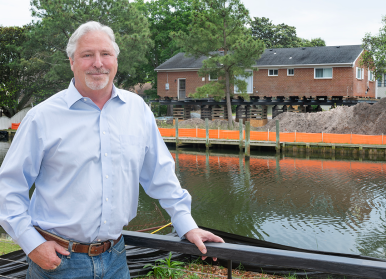EDITOR’S NOTE: On Aug. 20, a federal judge in Texas ruled against the Federal Trade Commission’s ban on noncompete agreements, which was scheduled to go into effect Sept. 4. In striking down the FTC‘s pending rule, U.S. District Judge Ada Brown called it “arbitrary and capricious” and an “unlawful agency action.” An FTC spokesperson said that the agency was considering an appeal of the verdict. The judge’s ruling does not impact existing state restrictions governing noncompete agreements.
Some Virginia attorneys have spent the past several months preparing clients for a potential future without noncompete agreements, even though there’s still a chance that a federal ban won’t become reality.
A four-month saga is ending in much the same way it began: marked by plenty of legal drama. In April, the Federal Trade Commission (FTC) issued a final rule banning noncompetes nationwide, barring employers from entering into such agreements with employees in the future and invalidating most existing clauses. That announcement was promptly met with various lawsuits that have been working their way through district courts ever since.
Like any good legal drama, there’s plenty of tension and suspense. Federal district court judges in Pennsylvania and Texas have split on whether the FTC has the regulatory authority to issue such a ban. In the days leading up to Sept. 4, when the rule is scheduled to take effect, all eyes will be on Texas, where a federal district judge who partially blocked the ban in early July plans to issue a ruling by Aug. 30.
Regardless of that decision, it’s likely the spotlight on noncompetes won’t dim anytime soon, as the FTC’s ban has been deeply contentious since the idea was first floated by the independent federal agency in early 2023. Ban supporters say it’s a win for workers and the economy more broadly. Opponents argue it will put valuable intellectual property at risk and stifle innovation.
Former U.S. Secretary of Labor Eugene Scalia, a Washington, D.C.-based partner with international law firm Gibson, Dunn & Crutcher, has been an outspoken critic of the rule, and his legal team is representing Ryan LLC, the Dallas-based global tax services firm that first sued the FTC. That case, Ryan LLC v. FTC, is currently in the hands of the Texas federal district judge.
Ryan’s case has been supported by business organizations like the Society for Human Resource Management and the U.S. Chamber of Commerce, the latter of which is a co-plaintiff in the case. In short, Ryan filed its lawsuit out of concern it would no longer be able to protect the firm’s proprietary information if an employee took a job with a competitor. “The ban would make it easy for top professionals to go across the street and compete against us,” said Ryan’s chief legal officer, John Smith, in an interview with the Associated Press.
Scalia’s team is confident they’ll prevail with their challenge, according to Andrew G.I. Kilberg, a partner working on the case. But they’ve also been advising other clients, including those who are very concerned about the potential ban on noncompete agreements, about the merits of contingency planning. “The rule really harms them if it goes into effect,” Kilberg says.
The U.S. Chamber of Commerce and other business associations joined the team’s challenge in May. The “amazing outpouring of support” for the challenge is also a telling indication of the effect the FTC rule could have on various industries, Kilberg says: “It’s a dramatic expansion of federal authority that interferes with an important tool to protect investments, employee development, intellectual property and methods of doing business that sometimes take years to develop.”
Opportunity for review
Many lawyers are similarly skeptical of whether the FTC’s ban will prevail in court, which is why they’re generally advising clients to take a wait-and-see approach while the legal process plays out. But another, trickier-to-navigate outcome is possible: The noncompete ban could go into effect as planned but then prove to be short-lived, as it could be either struck down by a higher court or overturned by a second Trump administration if the former president is victorious in the November election.
Brint Ryan, owner of Ryan LLC, has previously advised Donald Trump on tax policy.

Regardless of what transpires at the federal level, a period of “waiting and watching mode” has still proven valuable, notes Leah Stiegler, a Richmond-based management-side employment attorney and principal at law firm Woods Rogers. “It’s at least forcing employers to take a look at what they’re doing with noncompetes and talk to legal counsel.”
The biggest red flag, Stiegler says, is when an employer wants to impose noncompetes on every single employee. But there are less-glaring issues that may need to be addressed once the dust settles. She categorizes these into two groups: noncompetes that should be scrapped altogether or not enforced, and noncompetes that require revisions to be more narrowly tailored and consistent with state law if the national ban doesn’t take effect.
As part of this review process, it’s also important to consider the wide variety of documents where noncompete clauses often appear, recommends John E. Thomas Jr., a partner focused on employment law at the Tysons office of Richmond law firm McGuireWoods. While people most often associate noncompetes with an employment offer letter, employers may also include them in equity plan agreements or LLC formation documents, he adds.
“We always explore the full gamut of possibilities where these types of clauses exist,” Thomas says.
Noncompetes in Virginia
If it’s been a while since you last looked at documents containing noncompete clauses, it’s possible state law has changed in the interim. Beginning in 2020, Virginia employers were prohibited from entering into, enforcing or threatening to enforce noncompete agreements with “low-wage employees,” with the current annual salary threshold set at $73,320.
Because Virginia courts don’t generally like these agreements, employers here should still undertake a thorough review of their noncompetes, even in the likely event the federal ban doesn’t take effect and the status quo remains, says Tom Spiggle, an employment law attorney based in Alexandria. “Make sure noncompetes are considered necessary and are well thought-out because Virginia courts will strike them down if they’re overbroad.”

While the disputed FTC rule is “the most bold initiative” yet, Thomas says, it’s part of a longer-running trend across the country, including in Virginia, in which courts don’t enforce noncompetes unless they’re narrowly tailored. “The trend toward unenforceability of noncompetes is not a new phenomenon,” he says.
What is new? Like Virginia, other states have revised noncompete laws in recent years, creating additional burdens for Virginia businesses with employees in other states, says Ryan Glasgow, a partner focused on labor and employment litigation in the Richmond office of law firm Hunton Andrews Kurth. “Taking a one-size-fits-all approach with noncompetes is risky.”
Stiegler adds that courts are often looking at three things when assessing the enforceability of noncompetes: geographic scope, duty scope and temporal scope. But some states, she says, may impose other requirements, like a salary threshold or a stipulation about the nature of an employee’s departure from the company.
In addition to ensuring compliance with state laws, employers should consider whether these clauses are appropriate on a job-by-job and employee-by-employee basis, Glasgow recommends. “What may be enforceable for one type of position may not be enforceable for another.”
A healthy ban?
Identifying what noncompetes are in place has been a straightforward endeavor for some companies and more burdensome for others, Glasgow notes. Likewise, determining who fits the FTC’s definition of “senior executives” — for whom existing noncompetes can remain in force if the FTC ban takes effect — has been “a bit of a headache” for big companies, he adds.
If the ban takes effect, employers will be required by Sept. 4 to provide notice to workers who are bound by an existing noncompete (except for senior executives) that the company will no longer be enforcing the agreements.
Because noncompetes are seen as essential within certain industries, many business advocates sprang into action when the ban began to be bandied about last year. The FTC estimates that 18% of U.S. workers are currently covered by noncompetes, while the American Medical Association estimates that 37% to 45% of physicians are impacted. (While the FTC ban doesn’t apply to nonprofits, the agency could review health care organizations’ nonprofit status.)
The rule could negatively impact recruiting efforts by health care systems, particularly in rural communities, according to Sean T. Connaughton, president and CEO of the Virginia Hospital & Healthcare Association. “This development is especially troubling at a time when the health care sector continues to contend with workforce shortages across many clinical roles,” he said in a statement.
For its part, along with other projected benefits to workers, businesses and the overall economy, the FTC estimates that the ban could lower health care costs by up to $194 billion over the next decade, stating that noncompetes are shown to drive health care system mergers and price increases.
But the Ryan case challenging the ban has questioned some of the FTC’s assertions, arguing it will result in less innovation. “At a large scale, it would be detrimental to the economy,” Kilberg says.
When considering what industries are most affected, health care is “the big one,” Spiggle says, though noncompetes are also commonplace among people working in sales and as government contractors.
Room for debate
More broadly, the attention on noncompetes could foster positive workplace relationships as employers and employees become more aware of issues addressed by the agreements, such as intellectual property and employee mobility, says Lillien Ellis, an assistant professor of leadership and organizations with the University of Virginia’s Darden School of Business. It’s important for employees to recognize why these agreements are so frequently relied upon by businesses — and for employers to understand why they can pose challenges for employees, she adds.
Noncompetes have never been a foolproof way to protect employers’ interests, and that’s become increasingly true as courts take inconsistent approaches to their enforceability, Stiegler notes. Companies still have a lot of leverage — including options that potentially have “more teeth” than simply barring an employee from working for a competitor, she adds. These include confidentiality, nondisclosure, nonsolicitation and clawback agreements, along with trade secret contracts.
But Glasgow cautions that employers should be prepared for extra scrutiny of workplace agreements if the ban takes effect. If those agreements are so broadly worded as to have the effect of preventing employees from working for competitors, they’ll likely be unenforceable, he adds.
Four months may not be enough time to fully put the debate about noncompetes to rest. When the FTC began considering the ban in 2023, it received more than 26,000 public comments, ranging from workers who felt they were unduly burdened by noncompetes to employers who see the agreements as essential to doing business.
Presuming the FTC’s ban is ultimately enjoined, Kilberg hopes that any future discussion of a national standard for noncompetes should be handled by Congress and not unelected commissioners.
Whether noncompetes are here to stay or on the way out, the debate about their merits could be a springboard for discussing issues like employee mobility and workplace dynamics, Ellis says. “Do we like the way employer-employee relations are being handled? Does everyone agree this is working? And, if not, what are we going to do about it?”




